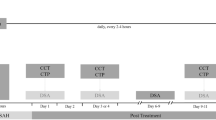Summary
Classification of brain infarcts based on the location, size and shape of parenchymal damage alone can be difficult and misleading. This is particularly true in subcortical infarctions and infarcts in so-called watershed areas between neighboring territories of the main hemispheric arteries. Pathogenetic mechanisms, signs and symptoms, lesion patterns in CT and MRI are discussed as well as angiomorphological conditions. Hemodynamically induced low-flow infarcts are rare and show typical, but not pathognomic lesion patterns on CT and MRI. Characteristic subcortical chainlike and confluent lesions are located in the supra- and paraventricular white matter, representing the core of a hemodynamically induced infarction. Definite diagnosis of low-flow infarcts requires information on the underlying complex vascular compromise of the extra- and intracranial arterial circulation. A noncompetent circle of Willis is the main predisposing condition in hemispheric low-flow infarcts even in severe occlusive disease of the internal carotid arteries.
Zusammenfassung
Die Klassifikation von Hemisphäreninfarkten allein nach Lage, Form und Ausdehnung der parenchymalen Läsion in der neuroradiologischen Schnittbilddiagnostik (CT,MRT) ist schwierig bei kleinen subkortikalen Infarkten und Infarkten an der postulierten Grenze zwischen Anterior-, Media- und Posteriorterritorium. Differentialdiagnostisch kommen neben hämodynamisch verursachten Infarkten thromboembolische oder mikroangiopathische Gefäßverschlüsse in Frage. Im folgenden soll ein Überblick über pathogenetische Konzepte, die klinische Symptomatologie sowie die vaskulären Entstehungsbedingungen und Läsionsmuster subkortikaler Infarkte hämodynamischer Genese gegeben werden. Das CT- und MR-morphologische Bild der subkortikalen Marklagerläsionen, die solitär, kettenförmig oder konfluierend sein können, ist zwar typisch, aber nicht spezifisch für Endstrominfarkte. Die Diagnose setzt die Kenntnis des angiomorphologischen Bedingungsgefüges voraus. Neben Stenosen der großen zerebralen Arterien ist zusätzlich eine Beeinträchtigung des Circulus Willisi zu fordern, so daß ein häufig assoziierter, uni- oder bilateraler Verschlußprozeß der Aa. carotides nicht ausreichend über Kollateralen kompensiert werden kann.
Similar content being viewed by others
Author information
Authors and Affiliations
Rights and permissions
About this article
Cite this article
Mull, M. Hemodynamically caused cerebral infarctions. Clinical importance of infarct pattern and angiomorphology. Radiologe 37, 871–877 (1997). https://doi.org/10.1007/s001170050296
Issue Date:
DOI: https://doi.org/10.1007/s001170050296




